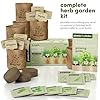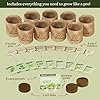Land Guard 8×4×2 ft Galvanized Raised Garden Bed Kit, Galvanized Planter Raised Garden Boxes Outdoor, Large Metal Raised Garden Beds for Vegetables.
30% OffCATMANOR 3 Pack 8x4FT Galvanized Raised Garden Bed Outdoor,Metal Garden Bed for Vegetables,Steel Raised Beds for Gardening,Above Ground Garden Box for Flower
$139.99 (as of 16:11 GMT -05:00 - More infoProduct prices and availability are accurate as of the date/time indicated and are subject to change. Any price and availability information displayed on [relevant Amazon Site(s), as applicable] at the time of purchase will apply to the purchase of this product.)Are you ready to start your vegetable garden? Whether this is your first time or you’re a seasoned gardener, there are always new tips and tricks to learn. In this blog post, we will cover everything from soil preparation and fertilization to harvesting and storage techniques. Let’s get started!
Soil Preparation and Fertilization for a Bountiful Harvest
The key to a successful vegetable garden starts with the soil. You want to make sure that your soil is rich in nutrients and has good drainage. Start by removing any debris or weeds from the area where you plan to plant your garden. Next, add compost and other organic matter to the soil to improve its texture and nutrient content. You can also use a soil test kit to determine what specific nutrients your soil needs.
Once you have prepared your soil, it’s time to think about fertilization. There are many different types of fertilizers available, but a general rule of thumb is to apply a balanced fertilizer (10-10-10) at the beginning of the growing season and again midway through. Be careful not to overfertilize, as this can harm your plants.
Planting and Care Tips for Common Vegetables
Now that you have prepared your soil and added fertilizer, it’s time to start planting your vegetables. Here are some tips for common vegetables:
Tomatoes: Plant tomatoes deep into the ground, leaving only the top few leaves above the surface. Pinch off suckers to encourage fruit production.
Lettuce: Sow seeds directly into the ground or start them indoors and transplant later. Keep lettuce well watered and protect from pests like slugs and snails.
Carrots: Sow carrot seeds thinly and cover lightly with soil. Thin seedlings once they have emerged. Water regularly and keep soil loose to prevent root damage.
Zucchini: Plant zucchini in hills rather than rows. Space each hill 3-5 feet apart. Water regularly and pinch off blossoms until fruits begin to form.
Pest Control in the Vegetable Garden
Unfortunately, no garden is immune to pests. However, there are several things you can do to control them naturally. For example, attract beneficial insects like ladybugs and lacewings to your garden by planting flowers like marigolds and lavender. You can also use natural remedies like neem oil or garlic spray to repel pests.

Harvesting and Storage Techniques to Extend Your Crop’s Shelf Life
Finally, let’s talk about how to harvest and store your crops so that you can enjoy them all year long. Here are some tips:
Pick produce when it is ripe but still firm.
Store vegetables properly to extend their shelf life. For example, store potatoes in a cool, dark place and wash greens just before using.
Freeze excess produce if you cannot eat it right away. This is especially useful for vegetables like green beans and peas.
In conclusion, starting a vegetable garden can be both rewarding and challenging. By following these tips and tricks, you should be able to grow a bountiful crop of delicious vegetables. Happy gardening!
Related Content
- Organic Gardening Tips You Can Try Today!
- $4.8 million awarded in grants for recycling and home hazardous waste
- Compostable plastic cutlery can be recycled into home-insulating foam
- FREE! Virtual Backyard <b>Composting</b> Workshop – Environmental Programs – Events | Urbana Park …
- Compostable Bags Market Segments, Opportunity, Growth And Forecast By End-Use Industry















































